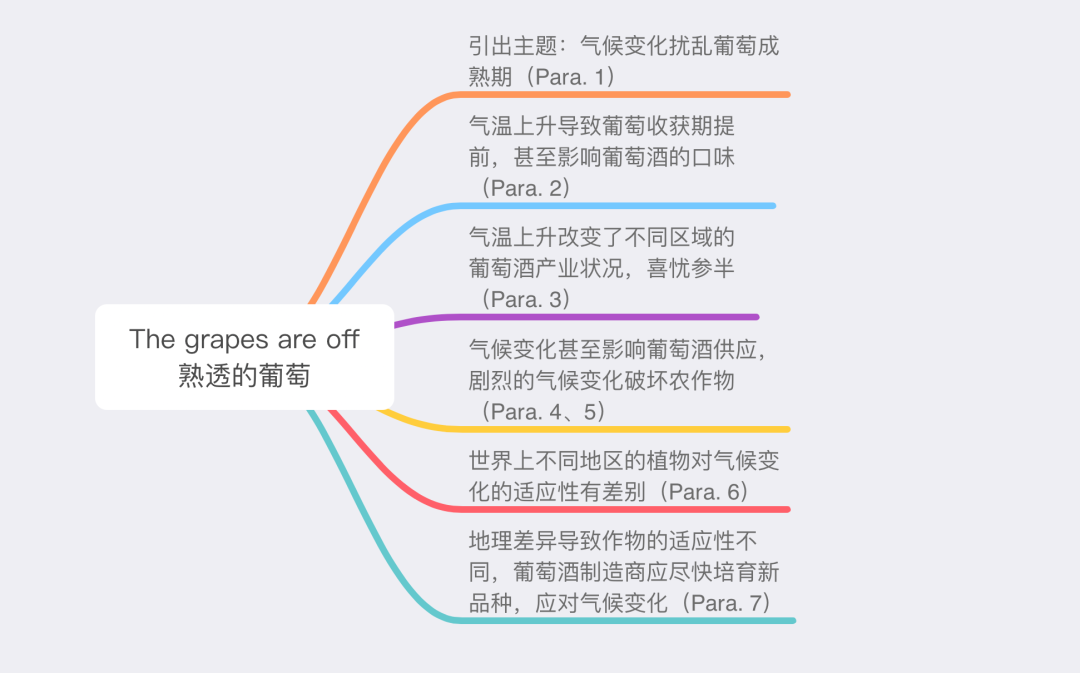每日外刊精读 The grapes are off 全球气候变换正影响着葡萄酒的口感

文章来源:《经济学人》Jul 17th 2021 期 Europe 栏目
Climate change is affecting wine flavours
气候变化正在影响葡萄酒的味道
The grapes are off
葡萄脱落了
British bubbly is getting easier to make; French grapes are threatened
#英国香槟酒越来越容易制作;法国葡萄却受到威胁
Jul 17th 2021
IN THE FOOTHILLS of Chianti Classico in central Italy, Elena Lapini and her husband make their way down neat rows of grapevines and inspect their fruit. The grapes are ripening too fast under the blistering sun. Too much bronzing on the vine and they will wither into raisins, turning the wine into a syrupy, unpleasant blend. Getting the harvest date right is crucial for this reason, Mrs Lapini says. But climate change is making it increasingly hard.
FOOTHILLS 山麓丘陵
grapevine 葡萄藤
raisin 葡萄干
syrupy 糖浆状的;甜腻腻的
在意大利中部的经典基安蒂山麓,Elena Lapini和她的丈夫沿着一排排整齐的葡萄藤走下去,检查他们的果实。葡萄在烈日下成熟得太快了。葡萄藤上晒的阳光过多,葡萄就会萎缩成葡萄干,使酒变成糖浆状的且难闻的混合物。Lapini说,因此,正确的收获日期至关重要。但气候变化正使其变得越来越困难。
An analysis of harvest dates going back to 1354 from Burgundy in France found that air temperatures have increased so much that grapes are now harvested two weeks earlier than in medieval times. Higher peak temperatures have become the norm, with the biggest jump over the past 30 years. Elizabeth Wolkovich, a biologist at the University of British Columbia researching the impact of climate change on vineyards, says rising temperatures are also changing the taste of wine itself.
一项可追溯至1354年的法国勃艮第葡萄收获分析发现,气温上升非常快,以至于现在的葡萄收获时间比中世纪早了两周。更高的峰值温度已成为常态,这是过去30年来最大的一次跃升。英国哥伦比亚大学研究气候变化对葡萄园影响的生物学家Elizabeth Wolkovich称不断上升的气温也在改变葡萄酒本身的味道。
For some cooler regions, warming conditions have allowed winemakers to grow more flavourful berries and enjoy longer growing seasons. Germany, best known for its Riesling white wines, has become more favourable to the heat-loving grapes used to make reds like pinot noir. Parts of rain-sodden Britain now have the perfect climate to make sparkling wines, giving British bubbly from Kent and Sussex a fair fight against French champagne. But warmer places like France, Italy and Spain have had a rotten deal. Ripening grapes at a higher temperature means more sugar and less acid in the berry, making high-alcohol, honey-like wines.
rain-sodden 雨水浸湿的; 雨水浸透的
在一些较冷的地区,气候变暖使得酿酒师可以种植更美味的浆果,享受更长的生长季节。德国以出产威士莲白葡萄酒而闻名,现在更青睐于用喜爱高温的葡萄来酿造黑皮诺等红葡萄酒。英国的部分地区多雨,现在就有完美的气候来生产葡萄酒,这使得来自肯特和苏塞克斯的英国香槟酒与法国香槟有了公平的竞争。但是像法国、意大利和西班牙这样更暖和的地方却遭遇了一场糟糕的交易。在更高的温度下成熟的葡萄意味着浆果中会有更多的糖分和更少的酸,从而酿造出高酒精浓度,蜂蜜般的葡萄酒。
Climate change is threatening the world’s wine supply, not just the wines’ flavour. In April producers in Italy and France found themselves lighting thousands of bucket-sized candles to warm the air and ward off a killer frost that threatened to destroy buds emerging with the first warm spells of spring. It wasn’t enough. In some regions the frost wiped out 90% of the crop, resulting in an estimated €2bn loss. French officials described it as “probably the greatest agricultural catastrophe of the beginning of the 21st century”.
气候变化不仅威胁着葡萄酒的味道,还威胁着全球葡萄酒的供应。今年4月,意大利和法国的生产商们点燃了数千支桶大小的蜡烛,以让空气更暖和,抵御致命的霜冻,这种霜冻可能会破坏初春时节刚刚发芽的花蕾。造成的伤害远不止这些。在一些地区,霜冻摧毁了90%的农作物,造成估计20亿欧元的损失。法国官员将其描述为“可能是21世纪初最大的农业灾难”。
Scientists concluded that the plants were coaxed to bud early by record-breaking temperatures in March. This made the chilly nights of early April particularly damaging. Climate change may make such events more common.
coax 引诱; 诱使
科学家们得出结论,3月份破纪录的气温促使这些植物提前发芽。这使得四月初寒冷的夜晚极具破坏性。气候变化可能会使这类事件更加常见。
Some regions are better dressed for the weather; 51% of Europe’s shrublands are vulnerable, compared with just 7% in North America. Part of the problem is that European species are not well-adjusted to a warming world. They bud early, quickly reacting to warming air temperatures only to die once they suddenly drop. North America, by contrast, harbours cautious species with adaptive strategies. They do not bud until they have experienced a sufficiently long winter, regardless of short warm spells in spring.
有些地区的植物能够适应天气; 欧洲51%的灌木林地是脆弱的,而北美只有7%。部分问题在于欧洲物种没有很好地适应全球变暖。它们早早萌芽,对气温升高反应迅速,但一旦气温突然下降,它们就会死亡。相比之下,北美的物种都很谨慎,而且有着适应策略。它们在经历了足够长的冬季后才发芽,也不管春天有短暂的温暖期。
Geographical differences help explain why. With no east-west mountain ranges in North America, warm air from the Gulf of Mexico and cold air from Arctic regions move freely across the continent, creating large fluctuations in temperature over short time periods. Constantin Zohner, a biologist at ETH Zürich, jokes that plants don’t want to take any risks in such an unpredictable climate. European winemakers, he reckons, need to take note and plant more resilient and diverse varieties of vine. There is no time to lose.
地理差异有助于解释原因。由于北美没有东西走向的山脉,墨西哥湾的暖流和北极地区的冷空气在北美大陆上自由流动,在短时间内造成了气温的巨大波动。ETH Zürich的生物学家Constantin Zohner开玩笑说,植物不想在这种不可预测的气候中冒任何风险。他认为,欧洲的酿酒师需要注意这一点,种植适应能力强以及多样性的葡萄品种。
相关文章
- 外刊选读 Appa’s Crossword Magic
- 外刊选读The Week Junior|Should people get time off to care for pets?
- 英文名著|原版英语阅读导读|哈利波特与魔法石第6章 导读手册+音频
- 外刊阅读 | 麻省理工技术评论 | DeepSeek 如何打破 AI 规则?
- 外刊精读 | 春节申遗成功 China’s Spring Festival inscribed as UNESCO ICHH
- 外刊精读 | 新能源汽车的优点和缺点
- 外刊精读 | 如何让自己的新年计划不流于形式
- 经常午睡比不午睡更健康吗?Whether naps have short- and long-term benefits for your health


发表评论